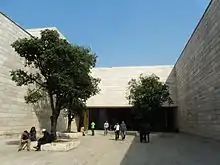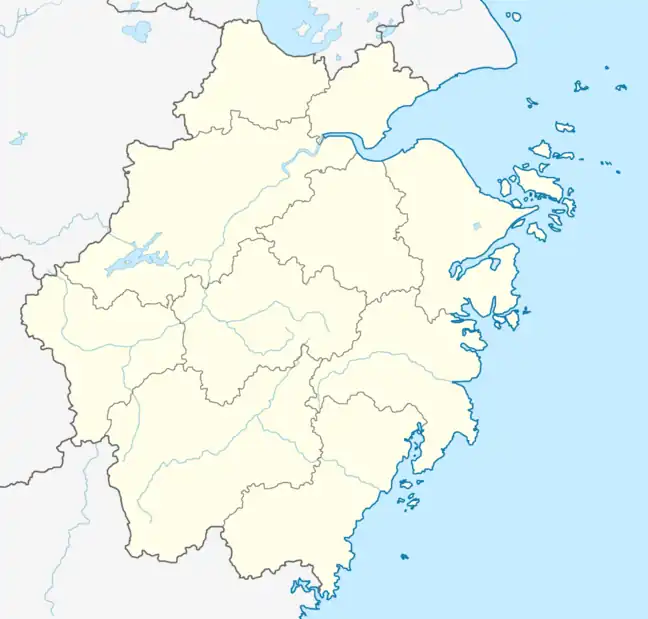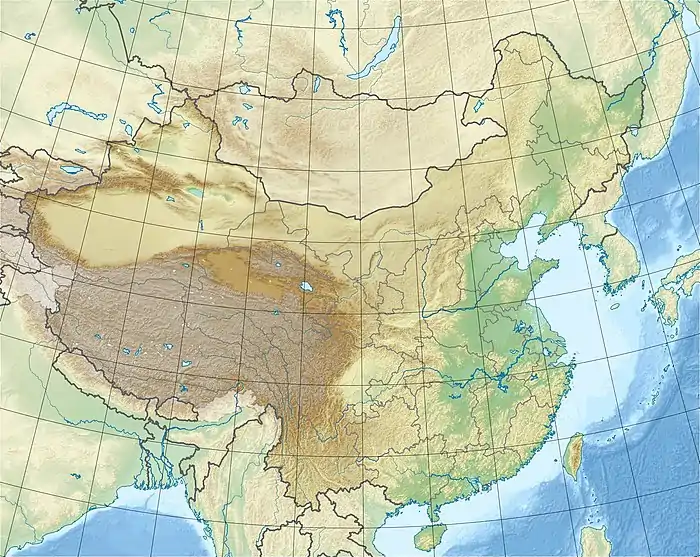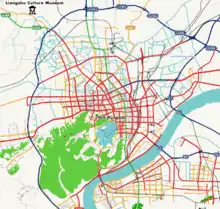 Courtyard outside the Liangzhu Museum | |
 Liangzhu Museum Location within Zhejiang  Liangzhu Museum Liangzhu Museum (China) | |
| Established | 7 January 2020 |
|---|---|
| Coordinates | 30°22′46″N 120°1′24″E / 30.37944°N 120.02333°E |
The Liangzhu Museum (Chinese: 良渚博物院; pinyin: Liángzhǔ Bówùyuàn) is an archaeological museum dedicated to the Neolithic Liangzhu culture. It houses a collection of artefacts from the archaeological culture. It is located in Liangzhu, in the northwestern outskirts of Hangzhou, the capital of Zhejiang Province, China.[1]
Origin of the name
The culture was first discovered in a small township called Liangzhu, in Hangzhou, Zhejiang in 1931, and so similar discoveries found near the site are altogether called Liangzhu culture. The Liangzhu culture is also known as the Jade culture and dates from 3000 BC.[2] The Museum is built on the site where many Liangzhu treasures were unearthed.[1]
History of the museum
The museum was designed by David Chipperfield Architects and completed in 2007.[2][3] The site was previously a contaminated industrial site, and has been landscaped into a park by Levin Monsigny Landschaftsarchitekten,[4] with hills and manmade streams.[5] The project took five years to design and construct, and was developed in conjunction with ZTUDI, the Architectural Design and Research Institute at Zhejiang University of Technology.[4]


Museum Layout
The Museum is stone-clad[5] with Iranian travertine stone[6] and is surrounded on three sides by a man-made lake.[5] It is built around an abstract geometrical design,[4] comprising four blocks, all 18 m wide but different heights, and lengths.[6] Five internal courtyards punctuate the space, connecting the galleries and allowing the entry of daylight.[5] Visitors enter the building via a bridge across the lake, echoing the aquaculture and irrigation systems of the Liangzhu people.[5]
The site uses more than 40,000 square meters, including 10,000 square meters of gross area, which consist of three conventional and a temporary exhibition and other function rooms. A courtyard at the back gives access across a second bridge to a small island on which outdoor exhibitions can be displayed.[5]
Liangzhu culture status
Liangzhu culture is one of the most important ancient cultures in the catchment area of the Yangtze because of its rice agriculture, elaborate handicraft industry and art achievement.[7]
See also
References
- 1 2 Carol Wiley (20 January 2011). The Road Less Travelled: Foreword by Bill Bryson. Dorling Kindersley Ltd. pp. 104–. ISBN 978-1-4053-6167-5. Retrieved 19 December 2011.
- 1 2 "Liangzhu Culture Museum, David Chipperfield Architects, Levin Monsigny Landschaftsarchitekten". MIMOA. Archived from the original on 5 December 2011. Retrieved 19 December 2011.
- ↑ "Liangzhu Culture Museum by David Chipperfield Architects". Coolboom. 11 September 2007. Retrieved 19 December 2011.
- 1 2 3 "Liangzhu Culture Museum by David Chipperfield Architects opens in Hangzhou, China". DETAIL - Institut für internationale Architektur Dokumentation. 13 November 2008. Retrieved 19 December 2011.
- 1 2 3 4 5 6 Rebecca Ward (April 2008). "Liangzhu Culture Museum". BusinessWeek/Architectural Record Awards. The McGraw-Hill Companies, Inc. Retrieved 19 December 2011.
- 1 2 "David Chipperfield Architects completes Ninetree Village and Liangzhu Culture Museum – the practice's first two projects in China". World Architecture News. 3 November 2008. Retrieved 19 December 2011.
- ↑ Peter Y. K. Lam (1998). Jades of the Liangzhu Culture: The Dawn of Chinese Civilization. [Hong Kong]: Chinese Univ of Hong Kong Art. ISBN 9627101400.